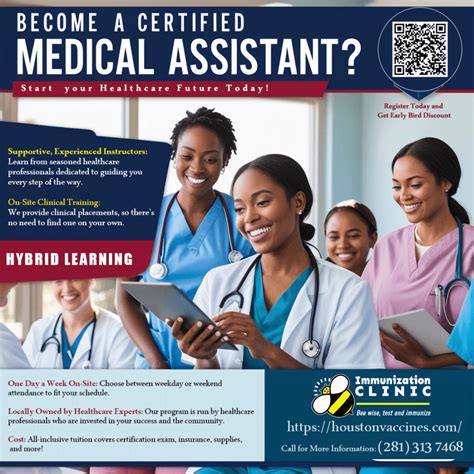Intro
Launch a rewarding healthcare career as a medical assistant. Learn the step-by-step process to become a certified medical assistant, including education requirements, training programs, and certification options. Discover the skills and duties of a medical assistant, job outlook, and salary ranges, and start your path to a fulfilling medical assisting career.
Are you passionate about healthcare and looking for a rewarding career that allows you to make a difference in people's lives? Becoming a medical assistant may be the perfect career path for you. Medical assistants play a vital role in healthcare teams, providing administrative and clinical support to healthcare professionals. In this article, we will provide a comprehensive guide on how to become a medical assistant, including the steps, requirements, and benefits of this exciting career.

What is a Medical Assistant?
A medical assistant is a healthcare professional who provides administrative and clinical support to healthcare professionals, such as physicians, nurses, and other medical staff. Medical assistants perform a variety of tasks, including taking vital signs, preparing patients for exams, administering medications, and updating medical records. They may also assist with medical procedures, collect lab samples, and communicate with patients and families.
Types of Medical Assistants
There are several types of medical assistants, including:
- Clinical medical assistants: These medical assistants work in clinical settings, such as hospitals, clinics, and physician's offices, and provide hands-on care to patients.
- Administrative medical assistants: These medical assistants work in administrative roles, such as medical billing, coding, and reception.
- Specialized medical assistants: These medical assistants work in specialized areas, such as pediatrics, gerontology, or oncology.
Steps to Become a Medical Assistant
Becoming a medical assistant requires a combination of education, training, and certification. Here are the steps to become a medical assistant:
Step 1: Earn a High School Diploma or Equivalent
The first step to becoming a medical assistant is to earn a high school diploma or equivalent. While in high school, take courses in science, mathematics, and computer skills to prepare for a career in healthcare.
Step 2: Complete a Medical Assistant Program
The next step is to complete a medical assistant program at a vocational school, community college, or university. These programs typically take one to two years to complete and include both classroom and clinical training.

Step 3: Gain Practical Experience
After completing a medical assistant program, gain practical experience by interning or volunteering at a healthcare facility. This will help you develop the skills and confidence you need to succeed as a medical assistant.
Step 4: Obtain Certification
While certification is not always required, it is highly recommended. The American Association of Medical Assistants (AAMA) offers the Certified Medical Assistant (CMA) certification, which is recognized nationally. To become certified, you must pass a certification exam and meet the eligibility requirements.
Step 5: Maintain Certification
To maintain certification, medical assistants must complete continuing education requirements and adhere to the AAMA's Code of Ethics.
Benefits of Being a Medical Assistant
Being a medical assistant has many benefits, including:
- Job satisfaction: Medical assistants play a vital role in healthcare teams and make a difference in people's lives.
- Job stability: The demand for medical assistants is high, and job stability is excellent.
- Career advancement: With experience and additional education, medical assistants can advance to leadership roles or specialize in a particular area.
- Competitive salary: Medical assistants are well-compensated, with median salaries ranging from $30,000 to $50,000 per year.

Skills and Qualities of a Medical Assistant
To be a successful medical assistant, you need to possess certain skills and qualities, including:
- Communication skills: Medical assistants must communicate effectively with patients, families, and healthcare professionals.
- Clinical skills: Medical assistants must have basic clinical skills, such as taking vital signs and preparing patients for exams.
- Administrative skills: Medical assistants must have basic administrative skills, such as medical billing and coding.
- Compassion and empathy: Medical assistants must be compassionate and empathetic when working with patients and families.
- Attention to detail: Medical assistants must be detail-oriented and accurate when performing tasks.
Work Environment of a Medical Assistant
Medical assistants work in a variety of settings, including:
- Hospitals
- Clinics
- Physician's offices
- Urgent care centers
- Nursing homes

Conclusion
Becoming a medical assistant is a rewarding career path that requires education, training, and certification. With the right skills and qualities, medical assistants can make a difference in people's lives and enjoy a stable and fulfilling career.
If you are interested in becoming a medical assistant, we encourage you to start by researching medical assistant programs in your area. With hard work and dedication, you can achieve your career goals and become a successful medical assistant.
What is the average salary of a medical assistant?
+The average salary of a medical assistant ranges from $30,000 to $50,000 per year, depending on location, experience, and employer.
Do medical assistants need to be certified?
+While certification is not always required, it is highly recommended. The American Association of Medical Assistants (AAMA) offers the Certified Medical Assistant (CMA) certification, which is recognized nationally.
What are the job responsibilities of a medical assistant?
+Medical assistants perform a variety of tasks, including taking vital signs, preparing patients for exams, administering medications, and updating medical records. They may also assist with medical procedures, collect lab samples, and communicate with patients and families.
